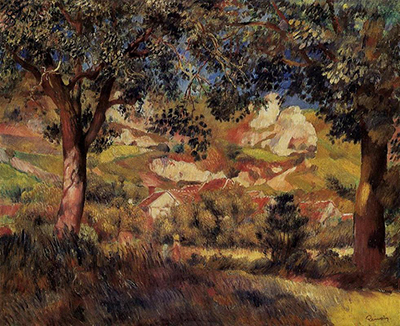Remarkable in radiance and vitality, Landscape in La Roche Guyon by Pierre-Auguste Renoir beautifully encapsulates a fervent motif resonating in brilliantly toned light beaming across the set in intricate planes of high impasto
Precise in brushwork and carefully painted in an intricate, frenetic, alla prima technique Renoir’s ‘Landscape in La Roche Guyon,’ reverberates the canvas merging a rich mix of bright colours without abruptly altering the sensual appeal of the painting.
Coalescing the luminosity of impressionism with a grander degree of masterful depictions, emulating the ambient tones of frescoes in a vibrant balance of colour and composition.
Pierre-Auguste Renoir, born February 25, 1841, Limoges France, was a French impressionist painter whose keen eye for flare and beauty made him one of the most renowned practitioners of the movement.
Renoir is famed for having a keen eye for capturing the flow of light and shadow, as well as, its relationship to objects, integrating more lines and compositions into creating some of his era’s most timeless canvases. His ambient portrayal of luminous colour, skillfully varying in brushstrokes, nuances of light and shadow all merged splendidly forming a warm sensuality that crowned him a leader of the impressionist movement.
As one of the founding enthusiasts of the impressionist style of painting, Renoir is a shrewd artist best known for his beautiful and astounding depiction of Pleasant scenery, Flowers, curvy women, and pretty children. Taking great pleasure in his work while drawing inspiration from great a variety of sources and experimenting with new techniques throughout his life’s career. A painter of Light, and the effects of pure and enhanced perception.
Impressionists in Renoir's era were considered radicals, breaking the rules of traditional painting and embracing a more natural approach in resonating ambience in lighting and colour of the canvas. Although the impressionism style of painting in France began when several other painters were intricately experimenting with plein-air painting, Renoir and his peers ushered-in new brilliant techniques that defined the movement.
As impressionism then became the norm other artists would be considered radicals, such as Pollock, Rothko, Hockney and Basquiat.
Highlights from New Yorker Basquiat include Untitled (Boxer), Irony of Negro Policeman, Obnoxious Liberals and Trumpet.
Their art was immediate, portraying movement with sincere compositions and vivid colours, a technique welcomed by the public at large, though shunned by art critics. The impressionist movement progressively paved the way for the rise of other painting panaches such as Neo-impressionism, post-impressionism, cubism, and Fauvism.
Renoir was the first impressionist devotee to detach from the movement's all too ultramodern direction, with his burning sensation and enthusiasm for painting being evident for all who him and observed his brilliant work. Some of Renoir’s most sensual works raging with supremacy throughout all of time and also most frequented reproductions in the history of art include The Bathers, Nude in the Sun, and the 1876 Dance at Le Moulin de la Galette (Bal du Moulin de la Galette).
Devoted to the beauty, joy of life, and the triumph of senses and vitality, Renoir is regarded as one of the final representatives of a tradition in painting which brought a rich feeling of warmth to the world and people in it.
His paintings are gentle and soft, neither symbolic nor profound with meaning; but they are lovely and restful reminders of a bygone age, sparkling with colour and vibrant in light. For him, a framework was supposed to be something pleasant, beautiful, and cheerful, for there are already too many unpleasant things in life and should not be the case to create even others.
Worth noting is that Pierre-Auguste Renoir was so avid and passionate about art, that even in his late years when he was old and suffering from severe arthritis, he painted with the brush tied to his wrists.




